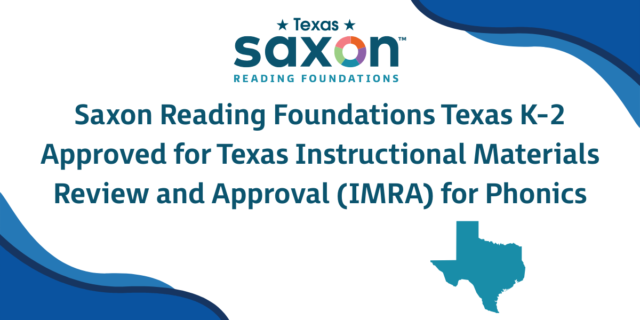
The 5 Pillars of Literacy—also known as the Big 5—have remained widely accepted by researchers and educators as core elements of effective reading instruction since the National Reading Panel’s report was first published in 2000.
Saxon® Reading Foundations primarily focuses on teaching phonemic awareness, phonics, and fluency while building children’s decoding skills. As children begin to establish a solid foundation in their early literacy skills, Saxon also incorporates the development of vocabulary and comprehension skills. Read on to dive deeper into each of the pillars that have informed the development of Saxon Reading Foundations.
What Are the 5 Pillars of Literacy?
Phonemic Awareness
Effective reading instruction in the early grades focuses on helping students understand the role of phonemic awareness in learning to read and write. Phonemic awareness refers to the ability to identify and manipulate individual speech sounds in oral language (NICHD, 2000). For example, the word cap has three phonemes (/k/, /a/, /p/), and the word clasp has five phonemes (/k/, /l/, /a/, /s/, /p/).
Research indicates that phonemic awareness is essential to reading success, as it helps children connect sounds to letters when learning to decode. The National Reading Panel concluded that phonemic awareness and letter knowledge are the two best indicators of how well children will learn to read during the first two years of instruction.
Phonics
Once students develop phonemic awareness, they move on to phonics—the relationship between written letters (graphemes) and the individual sounds they represent (phonemes). Systematic and explicit phonics instruction has been proven to be more effective than responsive or incidental phonics instruction (NICHD, 2000).
Mastering phonics allows students to decode words efficiently, leading to greater reading fluency. Effective reading programs also incorporate instruction in syllable structure and morphology (word parts like roots and affixes) to enhance pronunciation and meaning recognition.
Fluency
Fluency is the ability to read connected text smoothly and easily, acting as a bridge between decoding and comprehension (NICHD, 2000). It consists of three key elements:
- Accuracy: Correctly pronouncing words in a text.
- Rate: Reading at an appropriate speed to support comprehension.
- Prosody: Using expression, intonation, and phrasing.
When students achieve fluency, they free up cognitive resources to focus on comprehension rather than word recognition. Research shows that strong readers develop automaticity in word identification, allowing them to better understand and engage with texts.
Vocabulary Development
Vocabulary knowledge is a critical component of reading success. It includes knowing word meanings, understanding relationships between words, and recognizing words in various contexts. Research has shown that from third grade onward, vocabulary knowledge is a stronger predictor of academic achievement than decoding skill (Biemiller, 2012).
Effective vocabulary instruction combines direct teaching of new words, strategies for independent word learning, and exposure to rich, varied language experiences. Classroom activities that promote "word consciousness" and playful language exploration help students develop a deeper understanding of vocabulary.
Comprehension
Comprehension is the ultimate goal of reading. The Simple View of Reading states that comprehension is the product of word recognition and language understanding (Gough & Tunmer, 1986). Effective reading instruction includes modeling comprehension strategies, encouraging interactive discussions, and exposing students to high-quality literature in various genres.
Teachers play a crucial role in fostering comprehension by guiding students through analytical discussions, questioning techniques, and making connections between texts and real-world knowledge.
***
How Saxon® Reading Foundations Supports the 5 Pillars of Literacy
Saxon Reading Foundations primarily focuses on the decoding component of the Simple View of Reading. It is aligned with the phonemic awareness, phonics, and fluency pillars identified by the National Reading Panel as essential elements of effective reading instruction (NICHD, 2000). However, it also incorporates the development of the vocabulary knowledge and comprehension pillars as the students establish a solid foundation in their early literacy skills.
Saxon Reading Foundations is a supplemental series for grades K–2 that explicitly teaches phonemic awareness, phonics, and fluency in a way that is supported by scientific research and proven effective by years of classroom success. Saxon’s approach to teaching phonics and spelling concepts is based on solid foundational research in cognitive science and best practices in literacy instruction. It has been found to be consistently effective for children of varying ability levels and socioeconomic backgrounds.


